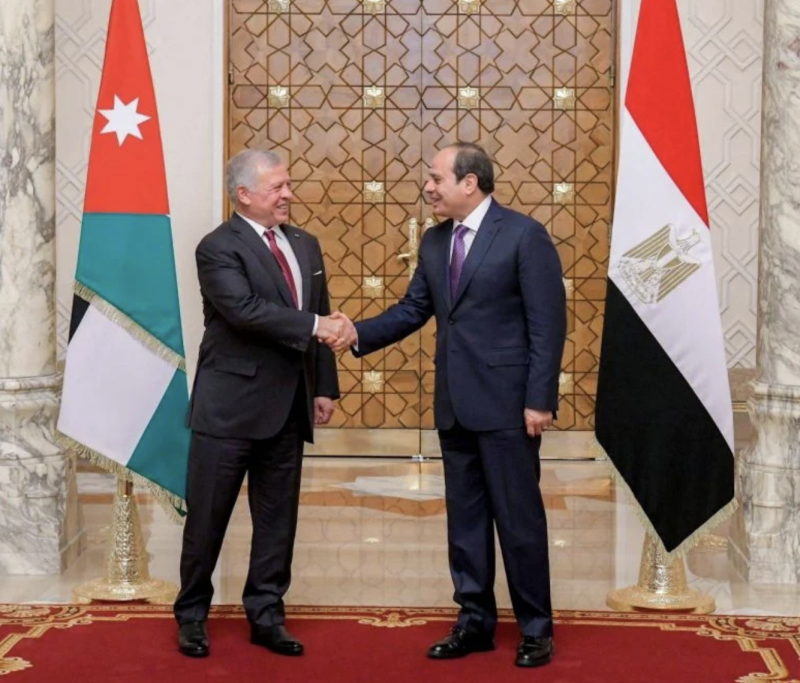
Egyptian President Abdel Fattah al-Sissi greets King Abdullah of Jordan on the sidelines of a summit on the Gaza conflict, held in Cairo, Dec. 27, 2023. (Credit: The Egyptian Presidency/Handout via Reuters)
Egypt and Qatar continue to make efforts for a ceasefire in the Gaza Strip and to propose political solutions for the management of the enclave once the Israeli operation is over.
While Israeli officials continue to say that the war will last for months, the latter is expected to enter into a new phase in January, L’Orient-Le Jour learned from an Arab diplomat and a Palestinian official.
“The ground offensive is expected to come to an end in the next two weeks, but without a ceasefire being declared,” said an Arab diplomat partaking in the negotiations.
The Israeli operation is expected to enter a phase of lower intensity involving more targeted strikes, which would enable the movement of Gaza Strip inhabitants within the enclave.
In the context of these negotiations, the future of Gaza remains unclear, particularly since Israel is determined to relocate a large number of Palestinians to neighboring countries. Israeli Prime Minister Benjamin Netanyahu recently confirmed that he is negotiating with several countries to take in Palestinians from the enclave.
The considerable damage that Israel inflicted on the north of the Gaza Strip and the destruction of infrastructure mean that the inhabitants of the north are confined to the south, which will not be able to accommodate them, paving the way for substantial population displacements.
Faced with this threat, Egypt and Qatar seek an agreement that would involve Israeli withdrawal from Gaza and the establishment of a new political authority.
Dahlan in Doha
This topic was also discussed in Doha, where CIA Director William Burns and Mossad Director David Barnea made a visit. For his part, Palestinian President Mahmoud Abbas tasked Azzam al-Ahmad, a Palestine Liberation Organization (PLO) official, with negotiating with Hamas the outlines of a new political formula.
According to L’Orient-Le Jour’s information, these negotiations have not reached an advanced stage for the moment. Another potentially key figure in the future course of events visited Doha three times since Oct. 7.
This figure is the former security chief in Gaza, Mohammed Dahlan. The UAE candidate for Palestine’s leadership met Hamas officials in Doha, two sources who followed the discussions told L’Orient-Le Jour. In fact, one of his close associates stayed in Doha to continue negotiations with the Islamist movement.
The former Palestinian minister and nephew of Yasser Arafat, Nasser al-Qudwa, and the former candidate for the PLO presidency Mustafa Barghouti, also took part in some of these meetings, which aim to restructure the PLO leadership.
Given Hamas’s popularity among Palestinians since Oct.7, no one is thinking of excluding the movement that Israel wants to eradicate.
A hypothesis was put forward in this vein. It would involve integrating Hamas into the governance of Gaza in the same way Hezbollah was integrated into Lebanese governments after the July 2006 war. While Hamas cannot be sidelined, it can no longer stand in the front line.
Three steps
Cairo is also preparing initiatives following the visit of Hamas leader Ismail Haniyeh last week. L’Orient-Le Jour learned from an Arab official that the Egyptian proposal involves a plan with several phases.
In the first phase, a ten-day humanitarian truce would be declared, during which Hamas would release all detained civilians in exchange for Israel releasing an agreed upon number of Palestinian prisoners, which would be agreed upon. They would be prisoners with reduced sentences and no major political clout.
This phase also involves a full ceasefire in all parts of the Gaza Strip, with the redeployment of Israeli forces away from residential areas and potential movement of citizens from the south to the north of the Gaza Strip, including vehicles and lorries.
This phase also includes the cessation of all forms of Israeli overflight, like reconnaissance aircraft, and the intensification of humanitarian aid deliveries and relief supplies, including to the northern areas.
The second phase would then involve the release of all female soldiers held by Hamas, in exchange for Israel releasing a number of Palestinian prisoners agreed upon by both sides, as well as the handover of all bodies that both sides have been holding since Oct. 7.
A distinction would be made between “Israeli reservists” and soldiers active on duty, and Israel would release Palestinians affiliated with Hamas involved in political, military and security activities. The Israelis would also include individuals recently arrested in Gaza in this agreement. This second phase would extend over a period of seven days, using the same criteria and procedures as the first.
The third phase involves a one-month long negotiation, during which Hamas would release all the soldiers it is holding in exchange for Israel releasing an agreed upon number of Palestinian prisoners.
This would involve the release of officers and soldiers on active duty, in exchange for the release of key prisoners such as Marwan Barghouti, Popular Front for the Liberation of Palestine (PFLP) Secretary General Ahmad Saadat, and Hamas leader Abdullah Barghouti.
This phase also includes the redeployment of Israeli forces outside the Gaza Strip borders, as well as the continued cessation of all aerial activities, while Hamas would undertake to cease all military activities against Israel.
According to an Arab diplomat who is following the negotiations closely, Israel reportedly agreed to the principle of a solution in phases. In parallel with the final phase, discussions are reportedly progressing on the proposal regarding a political vision for the future of Gaza, including how it would be governed and administered.
An international decision similar to Resolution 1701 regarding Lebanon would be possible. However, it could be adopted under Chapter VII rather than Chapter VI, requiring the dispatch of international or Arab forces to the Gaza Strip to oversee the cessation of military operations and consolidate stability.
This article was originally published by L'Orient-Le Jour. Translated by Joelle El Khoury.